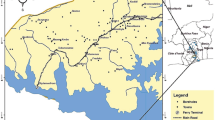Abstract
A modified DRASTIC model for groundwater vulnerability assessment (abbreviated as DRARCH model by combining the first letters of its six assessment indices) was proposed. It is essentially the specific application of DRASTIC model rather than a new model. Both natural hydrogeological conditions that prevent groundwater from contamination and important intrinsic hydrogeochemical properties of sediments in vadose zone that are related to the retardation of contaminants were considered as vulnerability indices. The DRARCH model consists of six indices: (1) Depth to the water table, (2) net Recharge, (3) Aquifer thickness, (4) Ratio of cumulative thickness of clay layers to total thickness of vadose zone, (5) Contaminant adsorption coefficient of sediment in vadose zone, and (6) Hydraulic conductivity of aquifer. The rating values and the weights of these vulnerability indices were obtained by contaminant transport simulation and factor analysis method respectively. Furthermore, the DRARCH model was applied to evaluate the groundwater vulnerability to arsenic contamination in Taiyuan basin, northern China, where groundwaters with high arsenic concentration occur in some localities. GIS-based mapping of groundwater vulnerability using this model indicates that the distribution of very high and high-vulnerability areas corresponds well to that of high-arsenic groundwaters. The DRARCH model is therefore reliable and useful for guiding groundwater environment management.




Similar content being viewed by others
References
Al-Adamat RAN, Foster IDL, Baban SMJ (2003) Groundwater vulnerability and risk mapping for the Basaltic aquifer of the Azraq basin of Jordan using GIS, Remote sensing and DRASTIC. Appl Geogr 23:303–324
Aller L, Bennet T, Lehr JH, Petty RJ, Hackett G (1987) DRASTIC: a standardized system for evaluating ground water pollution potential using hydrogeological settings. EPA/600/2-87-036, US Environmental Protection Agency, Ada, OK
Al-Senafy M, Abraham J (2004) Vulnerability of groundwater resources from agricultural activities in southern Kuwait. Agric Water Manage 64:1–15
Aronovsky RG (2000) Liability theories in contaminated groundwater litigation. J Environ Forensics 1:97–116
Burkart MR, Kolpin DW, James DE (1999) Assessing groundwater vulnerability to agrichemical contamination in the Midwest US. Water Sci Technol 39:103–112
Dixon B (2005) Groundwater vulnerability mapping: a GIS and fuzzy rule based integrated tool. Appl Geogr 25:327–347
Gogu RC, Dassargues A (2000) Current trends and future challenges in groundwater vulnerability assessment using overlay and index methods. Environ Geol 39(6):549–559
Goovaerts P (1997) Geostatistics for natural resource evaluation. Oxford University Press, New York
Guo H, Wang Y (2004) Specific vulnerability assessment using the MLPI model in Datong city, Shanxi province, China. Environ Geol 45:401–407
Kavanaugh MC (1996) An overview of the management of contaminated sites in the US: the conflict between technology and public policy. Water Sci Technol 34(7–8):275–283
Jin Y, Liang C, He G, Cao J, Ma F, Wang H, Ying B, Ji R (2003) Study on distribution of endemic arsenism in China. J Hyg Res 32(6):519–540 (in Chinese with English abstract)
Lake IR, Lovett AA, Hiscock KM, Betson M, Foley A, Sünnenberg G, Evers S, Fletcher S (2003) Evaluating factors influencing groundwater vulnerability to nitrate pollution: developing the potential of GIS. J Environ Manage 68:315–328
Lasserre F, Razack M, Banton O (1999) A GIS∼linked model for the assessment of nitrate contamination in groundwater. J Hydrol 224:81–90
Mádl-Szönyi J, Füle L (1998) Groundwater vulnerability assessment of the SW Trans-Danubian central range, Hungary. Environ Geol 35(1):9–18
Mcmahon PB, Dennehy KF, Sandstrom MW (1999) Hydraulic and geochemical performance of a permeable reactive barrier containing zero-valent iron, Denver Federal Center. Ground Water 37(3):396–404
Meinardi CR, Beusen AHW, Bollen MJS, Klepper O, Willems WJ (1995) Vulnerability to diffuse pollution and average nitrate contamination of European soils and groundwater. Water Sci Technol 31:159–165
Rizzo DM, Dougherty DE (1994) Characterization of aquifer properties using artificial neural networks: Neural Kriging. Water Resour Res 30:483–497
Smith B, Powell JH, Bradley AD, Gedeon R, Amro H (1995) Naturally occurring uranium pollution in Jordan. Mining Environ Manage 3(1):7–10
Soutter M, Musy A (1998) Coupling 1D Monte-Carlo simulations and geostatistics to assess groundwater vulnerability to pesticide contamination on a regional scale. J Contam Hydrol 32:25–39
Thapinta A, Hudak PF (2003) Use of geographic information systems for assessing groundwater pollution potential by pesticides in Central Thailand. Environ Int 29:87–93
Thunnissen HAM, Jaarsma MN, Schoumans OF (1992) Land cover inventory in the Netherlands using remote sensing; application in a soil and groundwater vulnerability assessment system. J Remote Sens 13(9):1693–1708
Wang Y, Ma T, Luo Z (2001) Geostatistical and geochemical analysis of surface water leakage into groundwater on a regional scale: a case study in the Liulin karst system, northwestern China. J Hydrol 246:223–234
Witkowski AJ, Rubin K, kowalczyk A, Rózkowski A, Wróbel J (2003) Groundwater vulnerability map of the Chrzanów karst-fissured Triassic aquifer (poland). Environ Geol 44:59–67
Worrall F, Besien T (2005) The vulnerability of groundwater to pesticide contamination estimated directly from observations of presence or absence in wells. J Hydrol 303:92–107
Vías JM, Andreo B, Perles MJ, Carrasco F (2005) A comparative study of four schemes for groundwater vulnerability mapping in a diffuse flow carbonate aquifer under Mediterranean climatic conditions. Environ Geol 47:586–595
Acknowledgments
The research work was financially supported by National Natural Science Foundation of China (Grant for outstanding young scholars, No. 40425001), China Geological Survey (No. CGS-200310400009) and the Research Foundation for Outstanding Young Teachers, China University of Geosciences (Wuhan) (No. CUGQNL0619). The manuscript greatly benefited from the helpful comments from two anonymous reviewers.
Author information
Authors and Affiliations
Corresponding author
Rights and permissions
About this article
Cite this article
Guo, Q., Wang, Y., Gao, X. et al. A new model (DRARCH) for assessing groundwater vulnerability to arsenic contamination at basin scale: a case study in Taiyuan basin, northern China. Environ Geol 52, 923–932 (2007). https://doi.org/10.1007/s00254-006-0534-4
Received:
Accepted:
Published:
Issue Date:
DOI: https://doi.org/10.1007/s00254-006-0534-4




